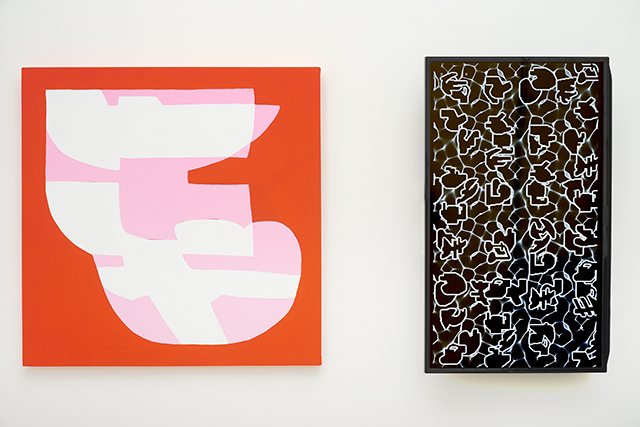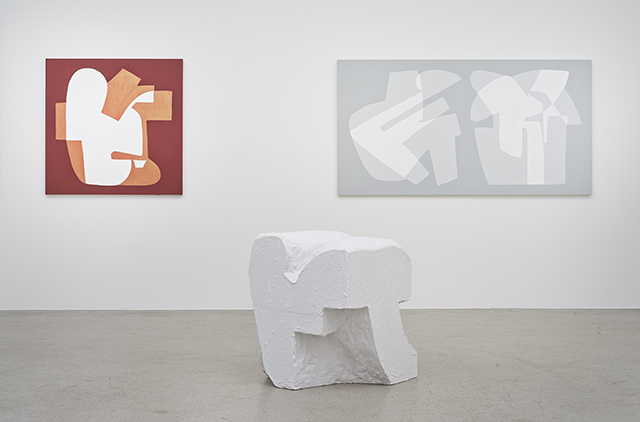The very first work on the image list for Hayal Pozanti’s solo exhibition at Jessica Silverman Gallery, 10, is both a title and a statistic. In Harper’s Index-like fashion, the image list details the number’s sobering source: “minimum number of stay days required by an inpatient internet-addiction program at a Pennsylvania hospital.”
Each work in Ciphers is a direct translation of data into a glyph alphabet of Pozanti’s own creation. With a limited repertoire of 31 “characters,” Pozanti uses the glyphs to create layered abstractions. A painting titled 36 contains the symbols for 3 and 6. These subdued works on canvas are accompanied by sculptures modeled after the shape’s intersections and custom CSS animations of a Windings-like language in motion.
Pozanti’s soothing palette belies the disturbing statistics at the root of her works. Purposefully made in earthy, non-digital tones (think warm grays instead of icy blues), her paintings are full of soft curves and hand-rendered edges. The source statistics pertain mostly to the influence of technology on our social and private lives: self-censorship, limited journalistic freedom, online stalking, surveillance and hacking threats.

Some of the information is shocking: one in ten people check their phones during sex. (Appropriately, 1/10 is painted in fluorescent pink and hot red acrylic.) Some of the information is, sadly, unsurprising: two thirds of those employed in computer occupations in the US are men. (2/3 stretches 6 feet 3 inches tall, a looming, human-sized canvas covered in bland hues of greenish beige.)
The four sculptures in Ciphers are made from blocks of painted foam, carved to reference the intersections of overlapping shapes in the surrounding paintings. The titles are snippets of tech jargon, things you might overhear as a group of start-up employees walk past your office window, like data-positive and chief privacy officer.
For this series, the square canvases become cubes, and the additive process of layering paint is reversed into the subtractive process of carving, shaving and shaping the foam. In varying shades of gray, the bulbous sculptures sit on the floor or atop more cubes – slick powder-coated metal tables.

The CSS animations hang behind the gallery’s front desk, with one monitor in the back showroom. Here the statistics return to the digital realm. The custom animations translate text into Pozanti’s characters, which scroll across the screens horizontally and vertically at varying speeds. It’s a bit like watching data flow in The Matrix. But instead of special-effects mumbo jumbo, these animated loops contain real statistics, making them more like a modern-day version of the 19th-century practice of cross writing.
As the “tech habits of teens” move from left to right, vibrant purple shapes scroll against a sparkly gray background. Next to the muted paintings and sculptures, the monitors practically vibrate.
Despite the density of information and the continuous stream of characters, the animations are impenetrable. Pozanti’s work is a puzzle. Certain discrete shapes become identifiable – or at least I like to think I figured out what “1” looks like – but without the key, the ciphers remain wholly her own.
Pozanti believes privacy and data encryption are the main issues of her generation (she was born in 1983), hence her interest in the statistics at hand. Her substitution cipher may not be advanced cryptography, but it is an enactment of the very issues preoccupying her. Her invented symbols create a framework for each sequential body of work. A letter becomes a glyph, the glyphs combine, their overlap becomes a sculpture, and so on and so forth.
Pozanti’s methodology has the logical precision of sequential steps, and yet it doesn’t grow old. Her 31 characters have been the basis for her practice for the past 5 years. This visual language couches the unsettling in the familiar trappings of abstraction, continuously jolting viewers from complacency to surprise. Just as 10 brings about a moment of self-reflective anxiety (do I have an internet addiction?), the works in Cipher position the viewer within a visualization of their own data, leaving us to consider the implications of freely giving that data to those who would gather it.
‘Ciphers’ is on view through Apr. 18, 2015 at Jessica Silverman Gallery. For more information, visit jessicasilvermangallery.com.